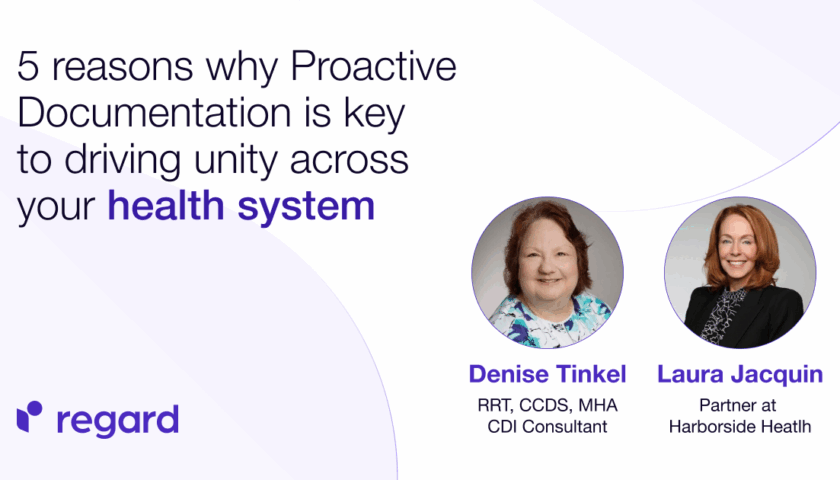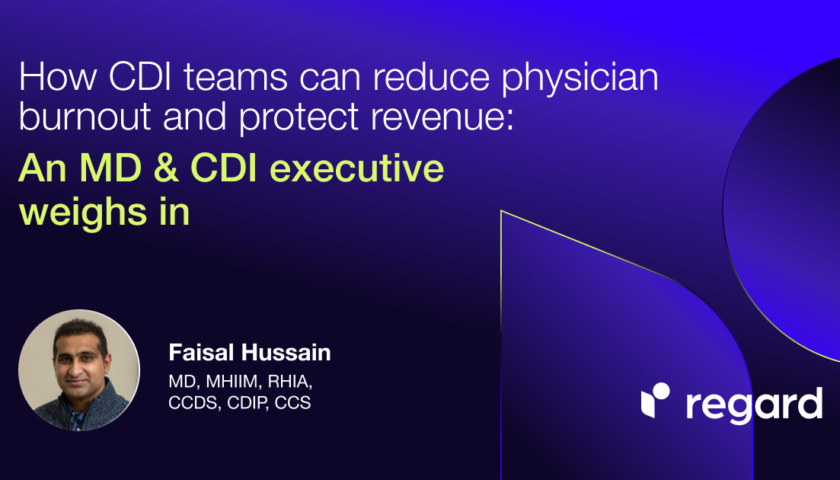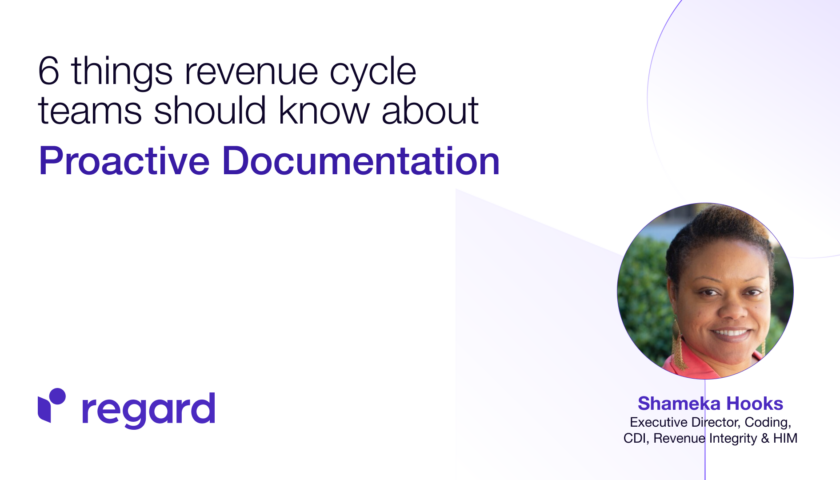
The healthcare industry is waking up to a new approach to clinical documentation. For years, doctors have seen their administrative workload increase and mental health decline; revenue teams have struggled to keep pace with complex and evolving insurance guidelines.
The current approach to documentation is a reactive chain that diminishes the fidelity of patient data and care at every step. This, in turn, allows reimbursement and revenue to fall through the cracks.
To explore opportunities for optimizing this reactive approach to documentation––including protecting and growing revenue––Nate Wilson, the president of Regard, joined Kate Gilfillan, director of healthcare finance policy and education at Healthcare Financial Management Association (HFMA), for a webinar on Proactive Documentation.
Expert guests included Shamika Hooks, executive director of mid-cycle operations at WakeMed, Dr. Faisal Hussein, executive director of clinical documentation improvement at Wellstar Health System, and Tamara Phams, associate vice president of coding and clinical documentation improvement at the Guthrie Clinic.
60% of attendees had never heard of Proactive Documentation.
Nate set the stage with a review of the status quo: a reactive approach to clinical documentation.. “We wait for clinicians to review data to diagnose and document; only then do we send a CDI query to clean things up afterwards,” Nate said. “That reactive approach puts more burden on the clinicians. But the root of this problem is actually that we have so much data, humans can’t keep up with it. On average, there are 50,000 data points on every single patient. There’s not enough time to review all of that at the point of care.”
Proactive Documentation has entered the scene as a way to resolve the symptoms of a reactive approach to documentation as well as the data overload that disadvantages the entire healthcare chain from the start. As Nate described, “Proactive Documentation gives the clinician a first draft of their clinical note before they even see the patient. It uses AI to review all of that data and surface diagnoses and insights, which in turn enables CDI, HIM, and quality teams to collaborate more effectively.”
These are the key takeaways from the expert panelists who shared their experiences with reactive processes and how Proactive Documentation can transform outcomes for patients, clinical teams, and revenue.
Learn more from the panelists and watch the webinar here.
Reactive documentation causes productivity and revenue to suffer
Experienced coding and revenue integrity professional Shameka Hooks described exactly how reactive documentation leads to inefficiency and tension across stakeholders––ultimately resulting in lost revenue. “Teams face several frustrations with reactive documentation, including process bottlenecks, delays in workflows, and the increased workload of chasing missing information, which is time consuming and stressful. Frequent account corrections increase operational costs and lower morale. The repetitive nature of fixing documentation issues can lead to burnout and decreased job satisfaction for both CDI teams and physicians.”
Dr. Hussein further described how expending manual effort to address process complexity can lead to productivity and revenue shortfalls. “It takes a long time to draft a query, because you must abide by all these rules and regulations that govern the practice. So, a high number of queries can impact the productivity of CDI, coding, and clinical team members. From the administrative leadership perspective, these unanswered queries delay billing, which jeopardizes potential revenue.”
According to Shameka, “Hospitals can lose millions of dollars annually, due to the unresolved claim denials. Every day, I use a Tableau dashboard to keep denials on my radar and dig into trends.”
CDI executive Tamara Phams and Dr. Hussein agreed that the magnitude of the problem can’t be overstated because of the small revenue margins that define the healthcare industry.
“National average denial rates are around 6%. That costs around $25 to $118 per claim. For uncorrected claims, we’re looking at an estimated loss of around 3% of net patient revenue.”
– Tamara Phams, Guthrie Clinic
Dr. Hussein described denials as a make or break factor for many hospitals. “Hospitals often run on very narrow operating margins, and denials add a significant revenue burden. Sometimes this means the difference between keeping the doors open or closed. At Wellstar, we track the trends in denials––from medical necessity to DRG downgrades, documentation, and clinical validation. The basis for most is lack of documentation or inadequate documentation,” he shared.
“According to many studies, up to 80% of denials are avoidable––and many of them are ultimately the result of documentation issues.”
– Faisal Hussain, MD, Wellstar Health System
Proactive Documentation benefits revenue teams and the bottom line
Healthier patients, healthier revenue
Regard CEO Nate Wilson painted a picture of the benefits Proactive Documentation brings to revenue. “We’ve seen improvements in observed versus expected length of stay, risk of mortality, severity of illness, and Vizient scores. Together, these reflect how sick patients are and how well the hospital is taking care of them. When you automatically check every patient for diseases and get a great first draft of clinical notes, you see dramatic financial impacts across a large number of metrics.”
“A Southwest Arizona health system saw $30 million in net new revenue, just from having deeper chart review and catching these things early.”
– Nate Wilson, Regard
Bypassing the cat and mouse game of insurance denials
Another key force working against revenue optimization in the reactive paradigm comes from the payor side of the equation. Nate explained, “It’s not uncommon for payors to have eight layers of AI in place to find opportunities to deny or slow down payments, whether or not it’s justified. While clinicians are delivering excellent care, documentation becomes the chessboard for some of these games. Having a holistic, proactive approach to documentation can help CDI and HIM teams empower clinicians to bring coding compliance to clinical work at the time of care. And it doesn’t add an additional burden to their plate.”
As a physician, Dr. Hussein echoed this assessment, describing how frustrating it can be for clinicians and CDI teams to predict and comply with insurance policies that appear designed to deny. “A lot of payors are using creative ways to deny coverage. One of the unfortunate strategies I see is payors using the queries themselves to cast doubt on the credibility of a diagnosis. For example, if the diagnosis is first mentioned as a response to a query, they may determine the diagnosis is invalid. That’s why it’s so important to be more proactive and more deliberate getting that documentation upfront rather than relying on fail-safe reactive documentation.”
All the panelists agreed that a Proactive Documentation solution stops unnecessary denials before they happen by suggesting appropriate diagnoses and drafting CDI-friendly notes with all the right information to sail smoothly through payor processing.
The hidden costs of reactive documentation
Regulatory risk
Poor productivity and the dance of insurance denials are not the only causes of lost revenue as a result of reactive documentation. Tamara pointed out how a reactive approach presents a liability for compliance. “Beyond time and resources, there is a regulatory component that comes up when we’re doing this reactive documentation,” she explained. “I’ve had PSIs go from a small group of individuals discussing it to the entire executive leadership team, along with our legal department.”
Physician burnout
One of the key challenges plaguing healthcare today is physician burnout, which is largely attributable to an overload of administrative duties. Speaking from personal experience, Dr. Hussein stated, “It can be very burdensome to answer CDI and coding queries. Nobody likes to take the work home and complete charting after a long day of seeing patients.”
50% of attendees reported a mild degree of friction between physicians and CDI team, and 25% reported a high degree.
He went on to assert that healthcare is not immune to ‘quiet quitting,” emphasizing the importance of implementing tools and processes that take better care of physicians. “It behooves us as an industry to reduce the cognitive load and administrative burden for physicians.”
Substandard patient experience
Shameka stressed that closely related to physician wellbeing, patients are next in line to suffer from reactive documentation. “It could potentially damage the patient relationship, satisfaction, and trust––particularly if the patient gets a notice from a payor stating their bill didn’t get paid due to coding or a denial.”
Nate contended that reactive documentation can even directly harm patient care through missed diagnoses. In contrast, he said, “If you have a Proactive Documentation platform that’s checking every patient every day for disease states, you might catch an atrial fibrillation that the clinician wasn’t aware of. Now you can actually deliver better care, better outcomes, and subsequently get the reimbursement.”
Dr Hussein shared how he believes Proactive Documentation can contribute to better patient care as well. “Improving the overall accuracy of the documentation creates better handoffs from one physician to the other across the continuum of care.”
Take the next step toward Proactive Documentation
To find out how a health system implemented Proactive Documentation to improve physician burden and protect revenue, download our Midwest health system solution brief If you’re ready to shift from reactive documentation to a proactive approach that improves patient care, physician wellbeing, and revenue, we’re here to help.


